Have you ever thought about what could happen if the earth ran out of food? Of course, most of us would all starve!
A good gardener who knows how to grow potatoes on his homestead won’t have to worry about anything.
As a good source of potassium, vitamin C, and healthy fats, potatoes can fill you for a good time. Don’t know how to grow this essential vegetable? Relax, as today, in this article, I will be sharing with you how to grow some yummy potatoes on your farmstead. I have got you covered, from the growing process to the delicious staple on your plate.
So, without any further ado, let’s get started!
7-Step Guide on How to Grow Potatoes in Your Homestead
Here’s a step-by-step guide on growing potatoes at your very own homestead.
Step 1: Choose Your Potato Type
Apart from being nutritious, potatoes are also known for their insane varieties. You can have sweet potatoes, russet potatoes, fingerling potatoes, and the list goes on. So, the first and most important step is deciding on the potato type you want.
Because I wanted a vegetable full of all nutrients that one can eat in any form, I went on with Yukon gold potato. Also, I recommend not to use spidery potatoes in your kitchen, as you will not get a reliable crop then.
Related: How To Breed New Potatoes
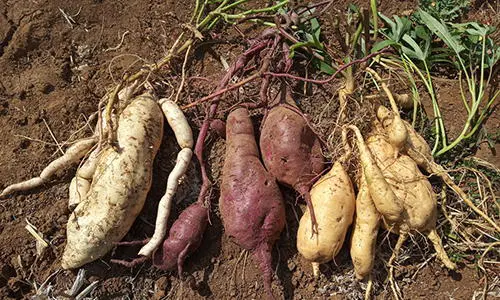
Step 2: Prepare Tubers
The next step is preparing the tubers, which you can do by chitting the potatoes. Chitting is simply the process of allowing the potatoes to grow stems or eyes, as we call it. You can do this by placing the potatoes in an egg tray.
Place this tray in an area with plenty of light and a cool temperature; ideally, a windowsill that doesn’t have direct sunlight would work fine. Have this tray rest for about six weeks or until they begin to produce shoots.
Remember to keep the below-mentioned points in your mind while chitting:
- If the stems are not getting too long, understand that the potatoes need more light.
- Remove any extra eyes on the potato using your fingers and let the best stem grow.
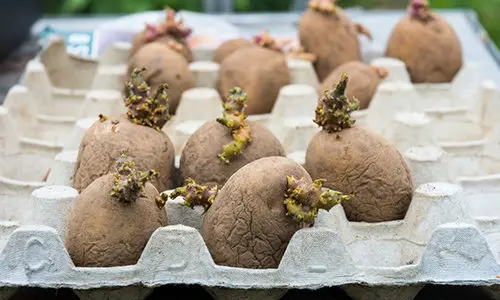
Step 3: Lookout for the Right Spot
Another important step is to find the right spot to plant potatoes. Trust me, the right site can do wonders for your crop. However, I would advise you to research what kind of soil condition would work best for your potatoes beforehand.
Potatoes better grow in a location with plenty of sunlight where frost is unlikely to occur. Also, avoid growing potatoes in the same spot where they had been grown in succession for about two years. A soil bed that you have previously used to plant potatoes is usually depleted of nutrients. As a result, the yield is poor, and you have to rely solely on fertilizers. Additionally, any disease in the previous crop might also affect the coming generation of potatoes; eventually, the contamination risk gets higher.
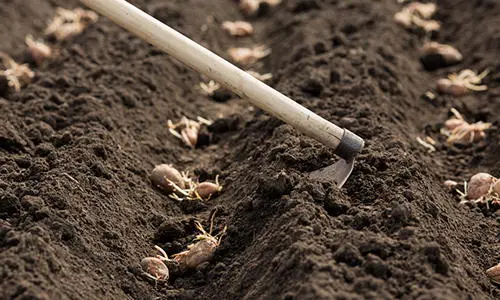
Step 4: Prepare the Soil
Once you have finalized the spot, the next thing you need to do is prepare the soil.
To start with this, have the ground ready using some good quality compost. Moist soil conditions would work fine for most types of potatoes, including the Yukon gold one. But remember not to make the soil too wet or compact as it won’t aid in good quality crop production.
Step 5: Plant the Potatoes
Now comes the real part: place the potatoes in the soil. For this, start digging a trench and have your potatoes planted 5 inches deep and 15 inches apart. To enhance the quality of the crop, try to cover them in compost.
I would also suggest keeping the compost well-watered on days when the weather is extremely dry. Remember, the more you look after your crops, the better the harvest will be obtained. But again, do not overwater the soil; otherwise, things might get worse.
It is important to maintain mild-wet soil for potatoes to grow.
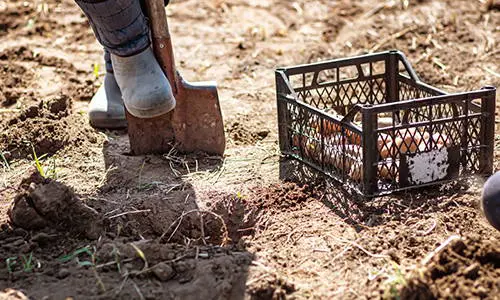
Step 6: Earthing up the Potatoes
Okay, this step is optional but worked well for me, so I thought, why not share it with you all?
So as soon as you notice that the green shoots from the potatoes have reached up to 12 inches in length, add extra soil. This process is known as earthing up, which helps protect the tubers from turning poisonous and increases the overall productivity of the crop. As an added benefit, this method also prevented my potatoes from turning green.
If you aren’t a huge fan of digging and earthing up, you can also grow your potatoes under black polythene to not let them turn green. This is a much more economical method and would not require you to earth up every now and then.
Related: How to Prepare Your Soil For Your Spring Garden
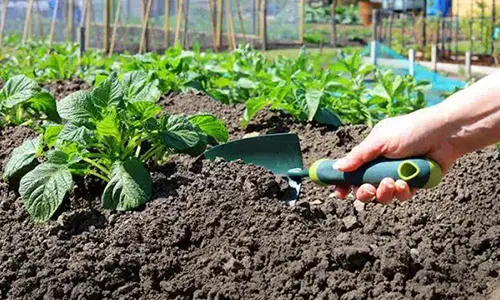
Step 7: Harvest Your Potatoes
So, when can you taste delicious, healthy, and all-organic potatoes from your own homestead? Let me give a tiny but indeed helpful tip. So, whenever you notice the flowers or, in simpler terms, the buds on the potatoes drop, acknowledge they are ready to harvest.
With reference to the time, it can be somewhere between 10 to 20 weeks after you have planted them. To pick fresh potatoes from your farm, dig up the whole potatoes using a spade.
A fork worked well for me, but you can use a spade for better precision. Make sure that you do not spear any potatoes as you are harvesting them. Your delicious fresh and organic potatoes are ready to eat!
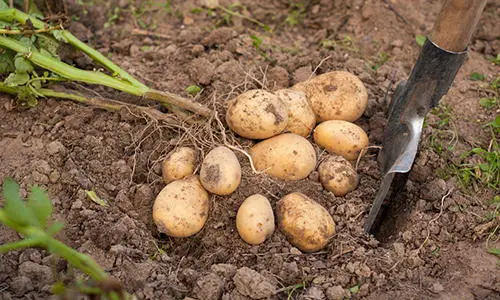
FAQ
- Q: When is the Right Time to Harvest Potatoes? A: The right time to harvest potatoes is between March, April, and May. Additionally, if you are planting first early potatoes, have them planted during the early spring season. On the other hand, if you are planting second early potatoes, have them in the mid-April season.
- Q: How Long Does It Take to Grow a Potato? A: It takes about 12 to 20 weeks for a potato to grow. In terms of days, it can take 80 to 100 days for potatoes to be ready to harvest. All in all, this time might also vary according to the type of potato you choose.
- Q: Can I Use Homestead Manure for Potatoes? A: Yes, you can use homestead manure for growing potatoes. Generally, potatoes are known to sprout on any kind of ground. However, the harvest is of the best quality if the soil is filled with the maneuver.
Bottom Line
A punch of vitamin C, fiber, and potassium makes potatoes an awesome vegetable to grow. With a wide range of varieties, I am sure you would never have to starve yourself to death.
By following the steps mentioned in this article, you can definitely become a pro at cultivating this valuable crop. Oh, and make sure to follow each and every step carefully to get the best results.
Happy homesteading!
You may also like:
 Strange Ways to Grow Potatoes In a Tiny Space
Strange Ways to Grow Potatoes In a Tiny Space
How to Build a Native American Subterranean Roundhouse in Your Backyard (Video)
How To Grow Food From Sawdust Blocks
If You Have This Plant in Your Backyard, You Will Never Run Out of Soap














